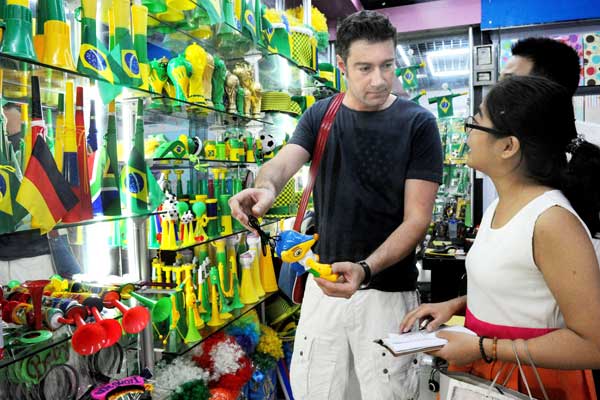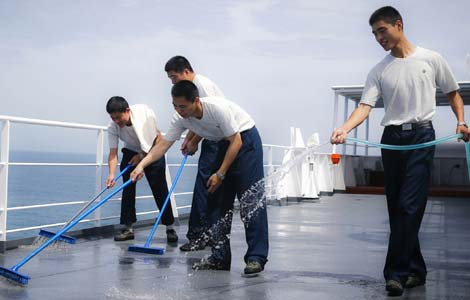Exporters to face more trade friction
Updated: 2013-09-17 00:25
By Li Jiabao (China Daily)
|
|||||||||||
Chinese exporters will continue to face increasing trade frictions in the second half of 2013 and in 2014 amid escalating trade protectionism moves and an uncertain economic recovery, said a report released on Monday by PricewaterhouseCoopers China.
Regarding the prospect of trade remedy cases targeting Chinese exporters, Damon Paling, trade and customs partner at PwC China, told China Daily that there's an increase in the overall (trade-remedy) cases, not just the frequency of cases.
 |
|
A Brazilian businessman examines sports memorabilia in Yiwu, Zhejiang province, for the 2014 World Cup, to be held in Brazil. PwC says that China will likely experience increasing trade friction from other emerging countries, such as Mexico, Brazil and India. ZHANG JIANCHENG / FOR CHINA DAILY |
"And the second trend is that we probably see increasing trade friction from emerging countries, such as Mexico, Brazil and India," he added.
China was the most-frequent target of trade remedy investigations in the past 17 years. In the first half of this year, China was hit by a total of 39 trade remedy investigations from 15 countries and regions, which "dented China's efforts to further expand its foreign trade", Xu Shaoshi, minister of the National Development and Reform Commission, China's top economic planning body, said in late August.
Xu added that the foundations of the global economic recovery are "still very fragile" with a sluggish recovery in developed economies and slow growth in emerging ones, which strengthened protectionist moves in trade and investment.
In 2012, 21 countries launched 77 trade remedy investigations against China with the total amount involved at about $27.7 billion. This was an increase of 11.6 percent year-on-year in the number of investigations and an increase of 369 percent in value compared with 2011, according to the Ministry of Commerce.
Overall trade in the world's second-largest economy rose 6.2 percent year-on-year in 2012.
"The rapid rise in disputes with emerging market economies has posed a threat to China's economy," the PwC report said.
Last year, emerging market countries launched 54 trade remedy probes against China, accounting for 70.1 percent of the total investigations.
"Emerging economies outstripped developed ones in terms of trade remedy investigations against Chinese exports in recent years as China shares a similar industrial structure with these emerging countries," said Wang Haifeng, a researcher with the Institute for International Economic Research of the National Development and Reform Commission.
Wang added that China will remain the biggest target of global trade remedy investigations before the country transforms its foreign trade structure in the next five to eight years.
"China's foreign trade expanded very fast in recent years. In addition, domestic exporters rely on low costs and low prices as their major competitive edge rather than establishing new advantages in innovation, brands and patents," Wang said.
Elton Huang, domestic market initiatives tax leader at PwC China, echoed that view, adding that a lack of innovative technology and manufacturing forecasting capabilities remain a weakness of some Chinese companies, contributing to an increase in trade friction.
"The gap between Chinese products' technical parameters and international standards still exists. Blind investment in production capability without proper forecasting mechanisms only leads to overcapacity," Huang said.
Chinese manufacturers and exporters should respond more proactively to disputes and investigations through revisiting business models and restructuring supply chains as both developed countries and emerging markets are taking action to restrict imports and encourage their own exports, PwC China said.
Regarding responses to trade remedy investigations, Paling said that in addition to preparing proactive responses to an investigation, meticulous planning is crucial to mitigating risks before an investigation is initiated. Best practices include making a self-assessment of dumping risks, understanding export measures and the overseas market environment, and exploring alternative export models, if needed.
Wang added that Chinese companies should firmly develop new competitive edges in branding, marketing and innovation while increasing investments in their export destinations to reduce friction risks.
Meanwhile, the Ministry of Commerce said on Monday that it will impose preliminary anti-subsidy duties of up to 6.5 percent starting on Sept 20, following much heftier anti-dumping duties — used for goods sold below market value — of 53.3 to 57 percent on US polysilicon in July.
Related Stories
Exports expand in Aug amid signs of recovery 2013-09-09 11:32
Trade disputes hit solar export prices 2013-08-10 09:50
Exports of Chinese PV products plummet in H1 2013-08-12 08:51
Vehicle exports down again 2013-08-10 08:33
Exports, spending 'to ebb' 2013-08-08 06:38
Today's Top News
List of approved GM food clarified
ID checks for express deliveries in Guangdong
Govt to expand elderly care
University asks freshmen to sign suicide disclaimer
Tibet gears up for new climbing season
Media asked to promote Sino-Indian ties
Shots fired at Washington Navy Yard
Minimum growth rate set at 7%
Hot Topics
Lunar probe , China growth forecasts, Emission rules get tougher, China seen through 'colored lens', International board,
Editor's Picks

|

|

|

|

|

|





